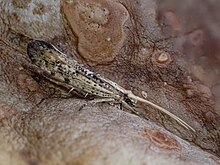| Orthenches chlorocoma | |
|---|---|

| |
| Scientific classification | |
| Kingdom: | Animalia |
| Phylum: | Arthropoda |
| Class: | Insecta |
| Order: | Lepidoptera |
| Family: | Plutellidae |
| Genus: | Orthenches |
| Species: | O. chlorocoma |
| Binomial name | |
| Orthenches chlorocoma Meyrick, 1885 | |
| Synonyms | |
| |
Orthenches chlorocoma is a moth of the family Plutellidae first described by Edward Meyrick in 1885. It is endemic to New Zealand and has been observed in the North and South Islands. The larvae of this species feed on native broom species in the genus Carmichaelia including Carmichaelia australis. Adults are on the wing in September, October and February.
Taxonomy
This species was first described by Edward Meyrick in November 1885 when a summary of his forecoming 1886 paper was published. In that publication the species was named as Orthenches chlorocroma. In 1886 Meyrick described this species in greater detail and used the name Orthenches chlorocoma. Meyrick used larvae collected in Christchurch from whom he bred one adult specimen in April. George Hudson discussed and illustrated this species in his 1928 book The butterflies and moths of New Zealand. Hudson went on to give a description of the behaviour of this species in 1939. J. S. Dugdale considered this species when describing the genus Chrysorthenches. The male holotype is held at the Natural History Museum, London.
Description

Meyrick described the larva and pupa of this species as follows:
Larva 16-legged, slender, attenuated towards both extremities, especially posteriorly ; whitish-brown or whitish-green ; a straight slender dorsal line and two rather irregular ill-defined lines on each side of it ochreous-brown or green, according to ground colour ; beneath these a rather broad yellowish-white spiracular line ; space beneath this dull brown; spots minute, black ; head grey-whitish or greenish-whitish, irregularly striped longitudinally with dark fuscous. Pupa in a rather thin firm spindle-shaped cocoon.
Meyrick described the adult of the species as follows:
Male. — 15 mm. Head and antennae pale whitish-yellowish. Palpi moderate, yellow whitish, second joint with a dark grey subapical band, terminal joint as long as second. Thorax pale whitish-yellowish, sides brownish. Abdomen ochreous-whitish. Legs fuscous, beneath whitish, anterior pair blackish. Fore-wings elongate, narrow, costa slightly sinuate, apex and hind-margin rounded ; fuscous- whitish, towards costa and base slightly yellowish-tinged, with thin irregular blackish irroration through-out, tending to accumulate in small spots, especially on margins ; a small round black spot in disc at 2⁄3 : cilia pale whitish-yellowish, suffusedly barred with blackish-grey. Hindwings elongate-ovate, with a scaled membranous ridge along lower median vein beneath ; grey-whitish ; cilia grey-whitish, at apex pale whitish-yellowish, with a blackish-grey spot.
Distribution
This species is endemic to New Zealand and has been observed in the North and South Islands. It has been collected at such locations as Auckland, Mount Taranaki, French Pass, Gore Bay, Waiho Gorge and Christchurch.
Habitat and hosts

This species feeds on native broom species in the genus Carmichaelia including Carmichaelia australis.
Behaviour
Larvae rest full length on the leafless stalks of its food plant. When disturbed the larvae can be very active. When at rest adult moths stand on fore- and intermediate legs, with wings wrapped around hind-body and the antennae placed close together, extended, forwards in a line with the body, and closely appressed to the object on which the moth is resting. The hind-body, together with wings, is held rigidly upwards at an angle of about 35 degrees. In this position the insect exactly resembles a dead twig of broom. Adults are on the wing in September, October and February.
References
- ^ Gordon, Dennis P., ed. (2010). New Zealand inventory of biodiversity: Kingdom animalia: chaetognatha, ecdysozoa, ichnofossils. Vol. 2. p. 463. ISBN 978-1-877257-93-3. OCLC 973607714. OL 25288394M. Wikidata Q45922947.
- ^ Dugdale , J. S. (23 September 1988). "Lepidoptera - annotated catalogue, and keys to family-group taxa". Fauna of New Zealand. 14. Department of Scientific and Industrial Research: 73. doi:10.7931/J2/FNZ.14. ISSN 0111-5383. Wikidata Q45083134.
- Edward Meyrick (November 1885). "Descriptions of New Zealand Microlepidoptera. Gelechiadae. VIII. Tineina (part)". New Zealand Journal of Science. 2 (12): 591. Wikidata Q108097450.
- ^ Edward Meyrick (May 1886). "Descriptions of New Zealand Micro-Lepidoptera". Transactions and Proceedings of the New Zealand Institute. 18: 175–176. ISSN 1176-6158. Wikidata Q109405465.
- ^ Hudson, G. V. (1928), The butterflies and moths of New Zealand, Illustrator: George Hudson, Wellington: Ferguson and Osborn Limited, p. 329, LCCN 88133764, OCLC 25449322, Wikidata Q58593286
 This article incorporates text from this source, which is in the public domain.
This article incorporates text from this source, which is in the public domain.
- ^ George Vernon Hudson (1939), A supplement to the butterflies and moths of New Zealand, Illustrator: George Hudson, Wellington: Ferguson and Osborn Limited, p. 463, OCLC 9742724, Wikidata Q109420935
 This article incorporates text from this source, which is in the public domain.
This article incorporates text from this source, which is in the public domain.
- J. S. Dugdale (January 1996). "Chrysorthenches new genus, conifer‐associated plutellid moths (Yponomeutoidea, Lepidoptera) in New Zealand and Australia". New Zealand Journal of Zoology. 23 (1): 33–59. doi:10.1080/03014223.1996.9518064. ISSN 0301-4223. Wikidata Q54576386.
- "Orthenches chlorocoma Meyrick, 1885". www.nzor.org.nz. Retrieved 2022-05-04.
- "Orthenches chlorocoma". iNaturalist. Retrieved 2024-01-09.
| Taxon identifiers | |
|---|---|
| Orthenches chlorocoma | |